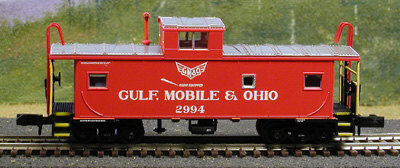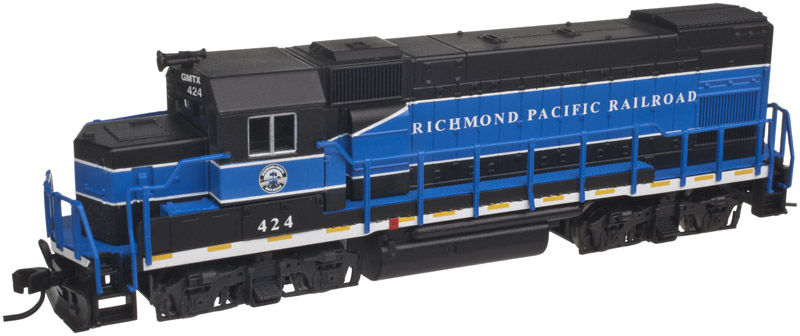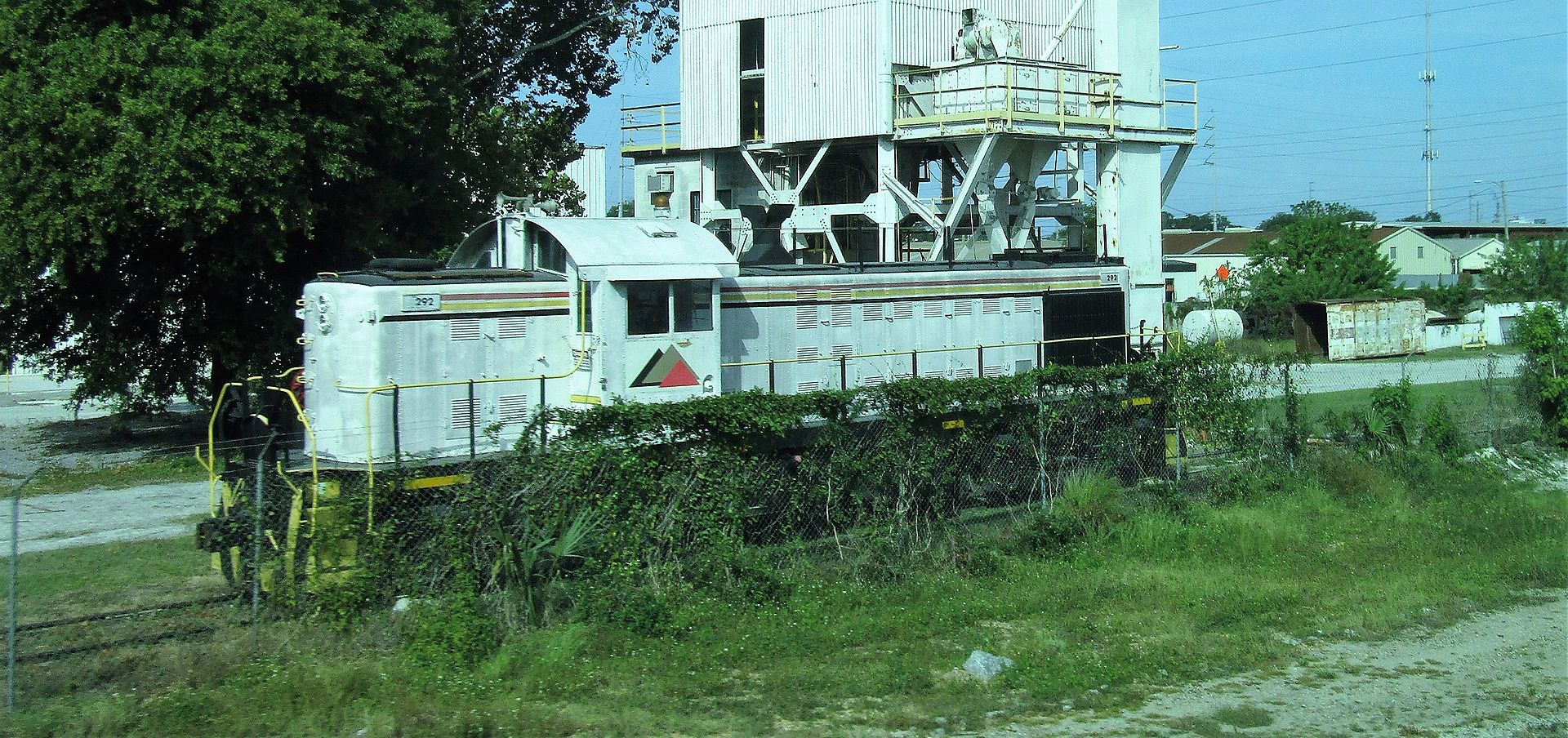Model Information: Atlas introduced this model in 1988. From 1988 - 1997 this model was produced for Atlas by Kato Japan. In 1998, a new version was designed by Atlas and production was moved to China.
Both versions feature a split-frame design with flywheels. They run smoothly and quietly, but despite the split frame they use a two-part lightboard. In my opinion they should have upgraded to a single-piece lightboard when they did the retooling in 1998 or better yet, introduced a NEM 651 socket. The detail on the shell is typical high quality Kato/Atlas work and the printing is crisp and accurate.
Both versions feature a split-frame design with flywheels. They run smoothly and quietly, but despite the split frame they use a two-part lightboard. In my opinion they should have upgraded to a single-piece lightboard when they did the retooling in 1998 or better yet, introduced a NEM 651 socket. The detail on the shell is typical high quality Kato/Atlas work and the printing is crisp and accurate.
DCC Information: These locomotives qualify as DCC-Friendly because even a relatively solder-clumsy idiot like myself can successfully install a TCS CN-Series decoder into one of these. It was a lot more work than a drop-in decoder, but there are lots of good internet resources explaining how to complete this. I was able to work off the well-written instructions included with the engine, but it was difficult enough, I have been hesitant to install anymore. Furthermore, the CN-Series decoders are a bit pricier than the simpler one-piece "drop-in" decoders most of us are familiar with. One note I would like to make is that the engine was much noisier with the decoder installed than it was when in DC mode. I suspect this was do to my sloppy installation technique, but I had been fairly careful and when I disassembled it to find the sources of the noise, I was baffled.
In summary, a nice engine for DC operations. If you want a DCC version, you can upgrade it yourself with some trouble or hire a pro to do it for you.
In summary, a nice engine for DC operations. If you want a DCC version, you can upgrade it yourself with some trouble or hire a pro to do it for you.
Prototype History: The ALCO RS-1 was a 4-axle diesel-electric locomotive built by Alco-GE between 1941 and 1953 and the American Locomotive Company from 1953 to 1960. The Montreal Locomotive Works built three RS-1s in 1954. This model has the distinction of having the longest production run of any diesel locomotive for the North American market. The RS-1 was in production for 19 years from the first unit Rock Island #748 in March 1941 to the last unit National of Mexico #5663 in March 1960.
The hood unit configuration of the RS-1 pioneered the road switcher type of diesel locomotive, beginning the move away from the carbody units which were the standard design for road diesel locomotives before then. Most North American locomotives built since have followed this basic design. In 1940, the Rock Island Railroad approached ALCO about building a locomotive for both road and switching service.
The first thirteen production locomotives were requisitioned by the US Army, the five railroads affected had to wait while replacements were manufactured. The requisitioned RS-1s were remanufactured by ALCO into six axle RSD-1s for use on the Trans Iranian Railroad to supply the Soviet Union during World War Two.
From Wikipedia
The hood unit configuration of the RS-1 pioneered the road switcher type of diesel locomotive, beginning the move away from the carbody units which were the standard design for road diesel locomotives before then. Most North American locomotives built since have followed this basic design. In 1940, the Rock Island Railroad approached ALCO about building a locomotive for both road and switching service.
The first thirteen production locomotives were requisitioned by the US Army, the five railroads affected had to wait while replacements were manufactured. The requisitioned RS-1s were remanufactured by ALCO into six axle RSD-1s for use on the Trans Iranian Railroad to supply the Soviet Union during World War Two.
From Wikipedia
Road Name History: The Great Northern was born in 1881 with the consolidation of several railroads of the northern plains under the leadership of James J. Hill. By 1893, the mainline from the Great Lakes and the Mississippi River to Seattle was complete.
The GN had two distinctly different characters. The eastern half was a largely flat, grain producing region serving cities like Fargo, the Twin Cities, Grand Forks, Duluth, Sioux Falls, Sioux City and even Winnipeg in Canada. The east end also included the iron ore rich regions of Minnesota. Half of North Dakota was blanketed by GN branchlines (21 in all) serving every imaginable grain elevator.
The western half is the mountainous portion that most people identify with Great Northern. This included crossing the northern Rockies and the even more difficult Cascade ranges. Cities on the western half included Billings, Butte, Helena, Havre, Spokane, Portland, Seattle, and Vancouver. In 1931, a connection to the Western Pacific was completed from Bieber north to Bend, Oregon. This line was disconnected from the rest of the Great Northern. They used trackage rights on the Oregon Trunk and SP&S to bridge the gap. The Cascade Tunnel, the longest on the continent at 7.8 miles, wasn’t completed until 1931. Construction included a massive sluiceway and hydro-electric power station to feed the electrified line through the tunnel and several miles of railroad on either side. This replaced the original Cascade Tunnel which was a third as long but 500 feet higher up the mountain. That replaced the original route that was another 700 feet higher, had 4% grades and 50 miles of snowsheds. All told, Great Northern had about 8,300 route miles.
The steam era was especially unkind to the Great Northern. They seemed to go out of their way to make their locomotives ugly. Belpaire fire boxes were the norm (made famous by the Pennsylvania, made hideous on the GN.) Headlights were often mounted just above center giving them a spinster look. Cab fronts were often at odd angles. The tender coal bunkers were often taller than the engines. But it wasn’t just aesthetics. GN had a knack for buying the wrong engines for the job. 150 Prarie type 2-6-2’s were so unstable at speed that they were busted down to branchline duty almost straight away and none survived after about 1930. Their first 4-8-2 Mountains built for passenger and fast freight were such a disaster, they were rebuilt into 2-10-2’s. Many railroads had built Mountains out of Mikes but no one had ever started with a Mountain and had to build something else from it. The first 2-6-6-2’s were so under-powered, the boilers were used to make Mikados instead. They did manage to build the largest, fastest, and most powerful Mikados in the country however. Their articulated fleet included 2-6-6-2, 2-6-8-0 (later rebuilt into Mikes), 2-8-8-0, 2-8-8-2 types as well as a pair of Challengers originally delivered to SP&S. Many engines were dressed up with green boilers and boxcar red cab roofs.
For the first generation of diesels, GN bought like many large railroads did: a sampling from everyone. Cab and hood units from EMD and Alco and switchers from EMD, Alco, and Baldwin populated the roster. GN’s first generation geeps and SD’s were delivered with the long hood as the front. This included their GP20’s which had high short hoods and the long hood as the front. Aside from an early black scheme for switchers, the GN fleet was delivered in Omaha Orange and green with yellow piping.
Beginning with the arrival of GP30s in 1962, the paint scheme was simplified by dropping the bottom orange band and the yellow piping. For the second generation, General Electric replaced Alco as a supplier of new road engines.
In 1962, some GN freight cars began to appear in Glacier Green which ran along side the vermilion paint adopted in 1956. In 1967, they went for a major shift. Sky Blue, white, and dark gray were joined by a new version of the Rocky the goat logo. There was talk that this would become the paint scheme for Burlington Northern. The GN name and logo was painted on a steel panel bolted the the hand railings of hood units, making it easier to remove after the merger. For whatever reason, they went with green, black and white, a version of which was simultaneously being tested on the Burlington Route. In 1970, Great Northern, Northern Pacific, Spokane Portland & Seattle, and Burlington Route merged to form Burlington Northern.
The GN had two distinctly different characters. The eastern half was a largely flat, grain producing region serving cities like Fargo, the Twin Cities, Grand Forks, Duluth, Sioux Falls, Sioux City and even Winnipeg in Canada. The east end also included the iron ore rich regions of Minnesota. Half of North Dakota was blanketed by GN branchlines (21 in all) serving every imaginable grain elevator.
The western half is the mountainous portion that most people identify with Great Northern. This included crossing the northern Rockies and the even more difficult Cascade ranges. Cities on the western half included Billings, Butte, Helena, Havre, Spokane, Portland, Seattle, and Vancouver. In 1931, a connection to the Western Pacific was completed from Bieber north to Bend, Oregon. This line was disconnected from the rest of the Great Northern. They used trackage rights on the Oregon Trunk and SP&S to bridge the gap. The Cascade Tunnel, the longest on the continent at 7.8 miles, wasn’t completed until 1931. Construction included a massive sluiceway and hydro-electric power station to feed the electrified line through the tunnel and several miles of railroad on either side. This replaced the original Cascade Tunnel which was a third as long but 500 feet higher up the mountain. That replaced the original route that was another 700 feet higher, had 4% grades and 50 miles of snowsheds. All told, Great Northern had about 8,300 route miles.
The steam era was especially unkind to the Great Northern. They seemed to go out of their way to make their locomotives ugly. Belpaire fire boxes were the norm (made famous by the Pennsylvania, made hideous on the GN.) Headlights were often mounted just above center giving them a spinster look. Cab fronts were often at odd angles. The tender coal bunkers were often taller than the engines. But it wasn’t just aesthetics. GN had a knack for buying the wrong engines for the job. 150 Prarie type 2-6-2’s were so unstable at speed that they were busted down to branchline duty almost straight away and none survived after about 1930. Their first 4-8-2 Mountains built for passenger and fast freight were such a disaster, they were rebuilt into 2-10-2’s. Many railroads had built Mountains out of Mikes but no one had ever started with a Mountain and had to build something else from it. The first 2-6-6-2’s were so under-powered, the boilers were used to make Mikados instead. They did manage to build the largest, fastest, and most powerful Mikados in the country however. Their articulated fleet included 2-6-6-2, 2-6-8-0 (later rebuilt into Mikes), 2-8-8-0, 2-8-8-2 types as well as a pair of Challengers originally delivered to SP&S. Many engines were dressed up with green boilers and boxcar red cab roofs.
For the first generation of diesels, GN bought like many large railroads did: a sampling from everyone. Cab and hood units from EMD and Alco and switchers from EMD, Alco, and Baldwin populated the roster. GN’s first generation geeps and SD’s were delivered with the long hood as the front. This included their GP20’s which had high short hoods and the long hood as the front. Aside from an early black scheme for switchers, the GN fleet was delivered in Omaha Orange and green with yellow piping.
Beginning with the arrival of GP30s in 1962, the paint scheme was simplified by dropping the bottom orange band and the yellow piping. For the second generation, General Electric replaced Alco as a supplier of new road engines.
In 1962, some GN freight cars began to appear in Glacier Green which ran along side the vermilion paint adopted in 1956. In 1967, they went for a major shift. Sky Blue, white, and dark gray were joined by a new version of the Rocky the goat logo. There was talk that this would become the paint scheme for Burlington Northern. The GN name and logo was painted on a steel panel bolted the the hand railings of hood units, making it easier to remove after the merger. For whatever reason, they went with green, black and white, a version of which was simultaneously being tested on the Burlington Route. In 1970, Great Northern, Northern Pacific, Spokane Portland & Seattle, and Burlington Route merged to form Burlington Northern.
Brand/Importer Information: In 1924 Stephan Schaffan, Sr. founded the Atlas Tool Company in Newark, New Jersey. In 1933 his son, Stephan Schaffan, Jr., came to work for his father at the age of sixteen. Steve Jr. built model airplanes as a hobby and frequented a local hobby shop. Being an enterprising young man, he would often ask the owner if there was anything he could do to earn some extra spending money. Tired of listening to his requests, the hobby-store owner threw some model railroad track parts his way and said, "Here, see if you can improve on this".
In those days, railroad modelers had to assemble and build everything from scratch. Steve Jr. created a "switch kit" which sold so well, that the entire family worked on them in the basement at night, while doing business as usual in the machine shop during the day.
Subsequently, Steve Jr. engineered the stapling of rail to fiber track, along with inventing the first practical rail joiner and pre-assembled turnouts and flexible track. All of these products, and more, helped to popularize model railroading and assisted in the creation of a mass-market hobby. The budding entrepreneur quickly outgrew the limitations of a basement and small garage operation. Realizing they could actually make a living selling track and related products, Steve and his father had the first factory built in Hillside, New Jersey at 413 Florence Avenue in 1947. On September 30, 1949, the Atlas Tool Company was officially incorporated as a New Jersey company.
In 1985, Steve was honored posthumously for his inventions by the Model Railroad Industry Association and was inducted into the Model Railroad Industry Hall of Fame in Baltimore, Maryland. In addition, Steve was nominated and entered into the National Model Railroad Association Pioneers of Model Railroading in 1995.
In the early 1990s, the Atlas Tool Company changed its name to Atlas Model Railroad Company, Inc.
In those days, railroad modelers had to assemble and build everything from scratch. Steve Jr. created a "switch kit" which sold so well, that the entire family worked on them in the basement at night, while doing business as usual in the machine shop during the day.
Subsequently, Steve Jr. engineered the stapling of rail to fiber track, along with inventing the first practical rail joiner and pre-assembled turnouts and flexible track. All of these products, and more, helped to popularize model railroading and assisted in the creation of a mass-market hobby. The budding entrepreneur quickly outgrew the limitations of a basement and small garage operation. Realizing they could actually make a living selling track and related products, Steve and his father had the first factory built in Hillside, New Jersey at 413 Florence Avenue in 1947. On September 30, 1949, the Atlas Tool Company was officially incorporated as a New Jersey company.
In 1985, Steve was honored posthumously for his inventions by the Model Railroad Industry Association and was inducted into the Model Railroad Industry Hall of Fame in Baltimore, Maryland. In addition, Steve was nominated and entered into the National Model Railroad Association Pioneers of Model Railroading in 1995.
In the early 1990s, the Atlas Tool Company changed its name to Atlas Model Railroad Company, Inc.
Manufacturer Information: 'Atlas Model Railroad' represents the New Jersey manufacturing facility for Atlas brand model railroad products. Atlas also imported European made models in their early years and those items will be noted as having manufacturers set appropriately. In the 1990s Atlas moved all their toolings to China.
Item created by: gdm on 2015-11-05 10:46:40. Last edited by gdm on 2018-05-22 19:50:17
If you see errors or missing data in this entry, please feel free to log in and edit it. Anyone with a Gmail account can log in instantly.
If you see errors or missing data in this entry, please feel free to log in and edit it. Anyone with a Gmail account can log in instantly.











